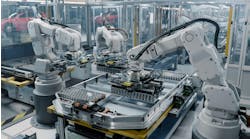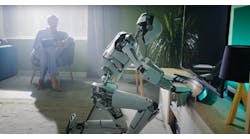While I don’t refer to it much, my primary role is that of technical/engineering support for a large consumer goods producer in the far northwest corner of Illinois. As a contract packager, we are constantly called upon to come up with ways to produce products for our clients using vintage machinery. Unlike a brand-name producer, private label companies don’t have the resources available to purchase new equipment that is specifically designed to manufacture the goods, so we rely on our expert knowledge of our equipment to get the job done.
One of the main challenges of being a co-packer of consumer goods is how to stay current with technology while keeping the bottom line profitable. An approach that has worked over the years is to build up our internal skills, so that we have been rather self-sufficient when it comes to modifying equipment to meet our needs. While we still depend on some well-developed relationships with our key vendors to be innovative, it is the skills of our team that carry us through from one project to another. Over the years we have become adept at modifying electrical and mechanical systems to meet our needs. However, like any producers of goods, we recognize that new technology allows us to produce more in a more economical fashion, so we have made significant investments to keep us competitive in the marketplace.
The mix of old and new technology, however, has given us a greater challenge. Like every other industry, our workforce is aging, and with it goes our developed skill base. For many years, we have been able to successfully hire from the local communities and, given time and patience, allow our people to develop the innovative skills necessary to support our production. Over the years, those same people become our setup and R&D teams that work on new product challenges. These past few years have seen some of our senior tradespeople retire after long careers with us. Much to our disappointment, we have found it harder and harder to bring in people to replace them. Periodically, we have been able to find a more senior team member that can help us, but the downside to that is the lack of experience on newer technologies. Nearly two years ago, we reached out to a local junior college with the purpose of helping to guide the curriculum so that the graduating students might have a good balance of skills that we would find desirable in an employee. What an interesting journey this has turned out to be.
When we first considered the idea of approaching the college, our team had an internal meeting first to establish some criteria for what we wanted in a potential candidate. The natural place to start would be to evaluate the skills of our existing employees and then identify any deficiencies that we would like to overcome with a new hire. The usual things came up: electrical troubleshooting skills for mechanics, a better understanding of sensors and pneumatics. Further, thinking about our newer lines and technologies, we added to that list with items such as basic computing skills, PLC and HMI programming, servo drives, stepper drives, distributed I/O, networking—suddenly, the list was sounding more like an engineer than a technician. We arrived at the place that many similar companies arrive at. We want to hire someone at a technician wage to do the job of an engineer, but still have the skills of a technician.
About 12 months ago, we hired the first intern from the program and, more recently, a second intern has joined our team. The experience, thus far, has been fantastic. Both interns are bright and clearly invested in their futures in this line of work. They come to work willing to learn and eager to accept new challenges. The more senior of the two has quickly become a called-upon member of the team, freeing up myself and my associate to focus more on projects and less on the day-to-day support of the maintenance team. The junior member will continue her education this fall and move to our third-shift PM team, where we plan to develop her hands-on skills in this very important part of our operations. The decision to develop an internship has already shown dividends as we have two existing members of our maintenance team who’ve indicated an interest in taking classes at the college to further their education and skills.
Our experiences thus far have brought about some interesting observations. The first revelation was a bit of a surprise, but only because we overlooked it when we laid out the requirements for our new generation of maintenance personnel. Our interns will come to us with experience programming current generation PLCs. While that is of enormous importance, it only covers about 30% of our current inventory of machines and processes. Most of our core packaging machinery uses PLCs that are from the late 1980s and 1990s. It is impressive that they are still working today, but that also means that anyone who will be expected to maintain this equipment must be able to understand the older technology and, more importantly, be able to get online and troubleshoot it. Our interns are learning the latest in IEC 61131-3 programming languages but that knowledge is of little use with the vintage PLCs still in use. What was long considered a European phenomenon, 61131-3 programmable controllers are mainstream, and it is very important to know how to program them. But there seems to be too much confidence being put into the “learn one PLC and you know them all” mentality. While that might be true of first learning the SLC-500 or Modicon 984 and then moving on to the newer tag-based programming, it isn’t that easy to go the opposite way. Formalized training in the vintage programming software would be immensely advantageous.
Another observation we have made after a year of our internship program is that our interns would benefit greatly from one or more courses and, more importantly, physical experience with robotics. Robots have a significant presence in packaging automation, and this trend is going to continue to grow rapidly in the next few years. The trend toward soft packaging, such as standup pouches, lends itself to robotic technology where a pick-and-place can package these products at a much higher rate and at a much higher degree of accuracy than a human can, but traditional packaging methods simply can’t do the job. Admittedly, we recently pulled out a robotic palletizer to replace it with a conventional palletizer, but the decision was as much a fiscal decision as it was about technology. Perhaps, if future interns come to us with robotics experience, we will feel better about utilizing them in future automation plans.
It is a great testament to the machine builders of the late 20th century that their creations continue to withstand the test of time. One thing that we have done to extend that presence is to put new control systems on these vintage machines. In most cases we have been able to simply migrate the existing programs over to the newer technology without having to rewrite the code. The advantage here is our experienced support techs are able to find what they are looking for because the code is virtually the same as it was 30 years ago, while our newer support techs, our interns, get to work in the confines of a programming software that they are already familiar with.
Newer trends—newer than 1990s or 2000s—that impact the technology and, by association, the educational expectations of the new generation of support techs, is the rapidly closing gap between variable frequency drives (VFDs), steppers and servos. Steppers and servos have been closing the gap for years to the point where the cost of a servo over a stepper is nearly negligent. Recent developments in VFD technology have allowed for closing the loop on a control system with an encoder to provide position feedback. While not nearly as accurate as a stepper or servo, the new VFD technology offers an economical solution to motion applications. All this means that a person coming through a college or university program needs to have real-world exposure, both in practice and in theory, to all three technologies so that they can be better equipped to not only troubleshoot systems but also to make an informed decision on what to use for the right application. Another reason to have these skills is that the older VFDs will eventually wear out, and direct replacements will become harder and harder to find. New-generation support techs will need to know how to pick the correct replacement part from the new technology and how to program it to meet or exceed the performance of the original.
ALSO READ: Who's that new robot on second shift?
Finally, a thorough knowledge of sensors is essential to the new generation. Most schools will teach the basics of the various sensors, but, without an interactive relationship between the sensor vendors and the college, the students will quickly find themselves trying to catch up on technology when they graduate. Methods of detection, types of materials sensed, color and texture detection are all part of today’s trends in sensors and the technology is evolving ever rapidly. The astute tech of tomorrow will leverage this technology to make older machines do better things with the products of today.
Our journey into internship and mentoring has been an eye opener. We are pleased with the results of what collaboration with our local college has produced thus far, and we are excited to see what the future brings. One comforting realization for my company was that the new generation comes equipped with a familiarization of touch and tablet technology, wireless networks and cloud computing, and these tools will be the basis of production support for years to come. Our more senior maintenance techs are reluctant to embrace the new technology, and the confidence is hard to come by. So, the future looks promising, and we are eager to see what skills the next generation will bring to the table.






